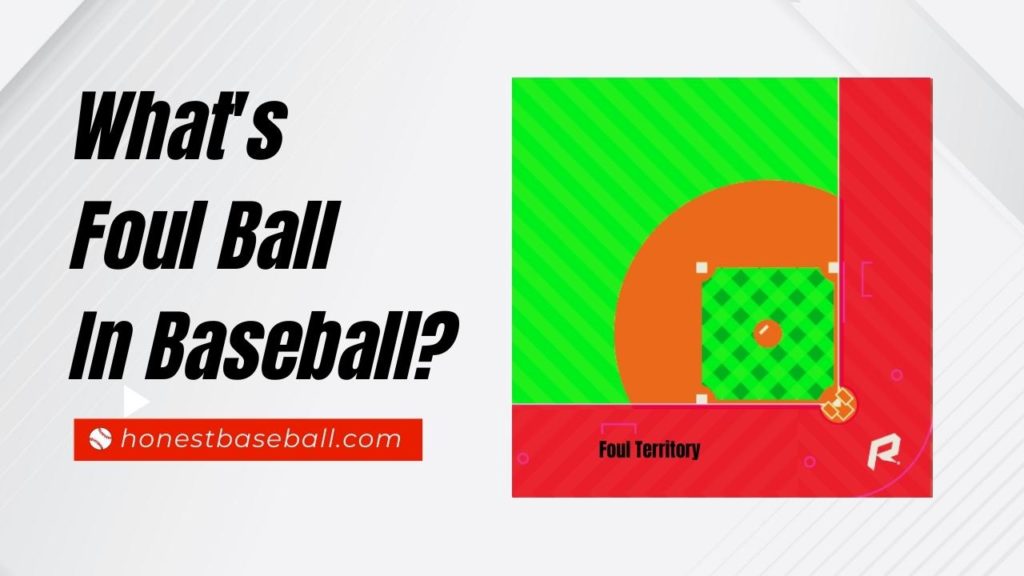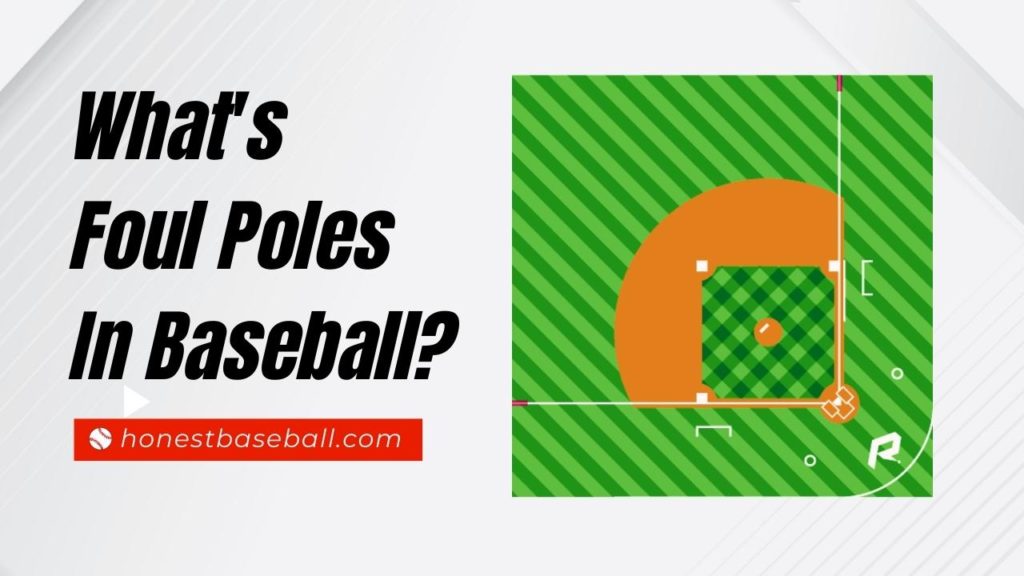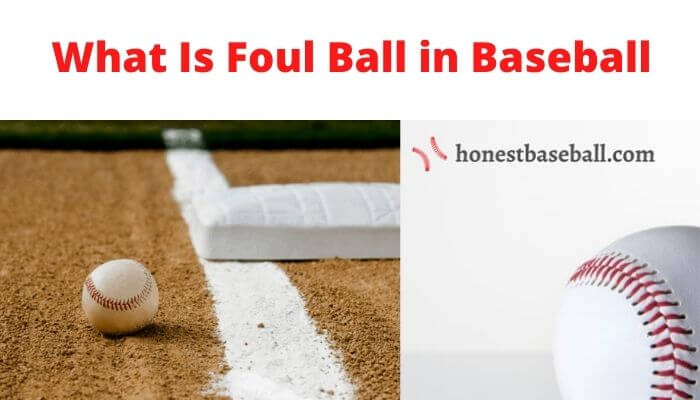Last Updated on July 8, 2022
Greetings, baseball lovers! Today, I’m back with another interesting topic that’ll intrigue all the baseball fanatics like you. What is foul ball in baseball and the consequences related to it? That’s what I’ll discuss in this article.
The major league baseball ground can have around 18,100 to 40,700 sq. ft. of foul territory while the fair playing area is 100,000 sq. ft. As the foul territory is quite smaller than the whole ground, there is less chance of foul balls per game.
But as a fresher, it’s essential to keep in mind the basic rules of baseball. It’ll help you to make mature decisions and react accordingly when you’re on the ground. And baseball fouls are something of that kind.
And it’s complicated too because of another rule called a foul tip. In brief, both are interrelated. The official baseball rules regarding foul balls have been changed in 2020.
Read along to learn more about these crazy rules in baseball, their nature, and how umpires differentiate them.
What’s Fair Ball in Baseball?

There are tons of terminologies in baseball. Before learning more about foul balls, you need to get a deeper understanding of the fair ball.
In short, any batted ball that stops in the fair territory is called a fair ball or the ball stays in the play. Whether it’s in the infield or outfield zones of the baseball field, the fair ball refers to the shots or pitches that are counted to keep on the game.
“Fair territory is any area in the baseball field that starts from home plate and ends before the foul lines.”
Another thing you should remember is that though 1st and 3rd bases are located next to the foul lines, the whole zone is considered a fair zone or territory. So, if your batted ball hits any of the bases first, it’s a fair ball.
Besides, it’s a fair ball if your ball rolls before meeting any of the baselines. But the ball should then drive over the lines.
What’s a Foul Ball in Baseball?

There are multiple conditions to identify whether it’s a foul ball or not. For example, when balls are hit by the batter and settle on the foul territory, the umpire will title it a foul ball.
“The zone outside the 1st and 3rd base lines and extended to the fence placed in front of the spectators is called foul territory”
Here, the foul territory is segmented into two. First one is the territory between the home and the 1st base. And the second one is the zone between the home base/plate and the 3rd base.
Although a century back, there was a more flexible definition of the foul ball. Alexander Cartwright quoted it. He said it’s a foul ball whenever the baseball runs out of the infield and continues to drive outside of any of 1st and 3rd base.
There were always arguments regarding the rule. Because of easy understanding, many players appreciated the rule.
However, many criticized the rule due to a lack of clarity and lack of control of specific events that occur frequently in baseball.
What are the Rules of Foul Ball?
As a coach, I understand the psychology of beginner baseball players. Thus, I don’t fill their minds with complex rules initially.
I just tell them any ball that lands in fair territory (the area inside the 90-degree lines on either side of the field) is called a fair ball. And if it crosses the lines, the umpire counts it as foul ball.
However, without the primary condition, there are some other factors that can determine it as foul balls.
- If the ball bounces out of 1st/3rd base, it’s a foul ball.
- Even if the ball bounces over the particular foul territory, it should be considered a foul ball by the umpire.
- The ball first falls on foul territory beyond the territories mentioned in 1.
- If the ball runs on and over the foul territory and touches the person there or the umpire, it’s a foul ball.
- In case the batted ball drives over or on the foul territory, contacts any external object such as an animal, consider it a foul ball.
- If the ball touches batters while standing on the home base, it’s even a foul ball.
How is Baseball Field and Boundaries Relevant to Foul Ball?
Besides the batter and catcher, the baseball field plays an important role to decide whether it’s a fair or a foul ball.
Typical Major League baseball fields have a size of 105k to 119k sq. ft. of area. It’s around 2.4-acre to 2.72-acre.
On the TV screen, it may seem like the stadium is large enough to accommodate those hard hits. But practically, it’s not always the same.
To get a more understanding of the foul ball rules, you should learn more about the basics of the baseball field.
Since it’s a ground sport, there are boundaries in baseball too just like any sport. The ad board or fence you see on the baseball field are the natural boundaries.
Inside them, there are also 2 white foul lines available, connecting the home plate or batters base. Both these are outlined at a 90-degree angle. The right line is called the first base and the left line is known as 3rd base.
More specifically, there are two parts of the baseball field mainly, the infield and outfield. The reason it’s called foul in the infield may differ from the condition of the outfield.
Rules of Foul Ball in the Infield
In a broader sense, any ball that may enter as a fair ball but result in a foul ball occurs inside the infield territory. And it often happens in baseball. When deciding on a foul or fair ball, you should look at the stopping point or touching point.
The infield consists of a mixed area of grass and dirt. It’s also called the diamond area because of the shape.
Also, infields are the most exciting part of the baseball game as the pitcher, batter, and catcher all play their role inside the area. Without them, the 1st, 2nd, and the 3rd baseman also hold their position in the infield.
Unlike the outfield area, to determine whether it’s a foul ball or a fair ball, the umpire inspects where the ball touches after being hit by the batter.
It’s also essential to identify the ball location after crossing the 1st or 3rd base. The ball that bears inside the foul zone before reaching 1st/3rd bases is also foul.
Rules of Foul Ball in Outfield

Beyond the infield area, those whole grassy areas are called outfields in baseball. The typical player roles in this area are right fielder, left fielder, and center fielder. Their core responsibility is to tackle the boundary line during the match.
When it comes to considering foul or fair balls inside the outfield zone, the primary factor is the dock spot of the ball.
Suppose, your batted ball landed in the foul area and then bounced back to the fair zone, it’s considered a foul ball. If the ball hits the foul pole, it won’t be a foul ball.
“Foul poles are the stands that are placed at the outfield fence. These are actually center zones where the fence and foul lines meet together.”
Another interesting fact is that whenever your ball hits the ball but doesn’t bounce back to the outfield, it’s a home run.
On the contrary, the ball doesn’t bounce and straightly hits the pole, this is called Ground-Rule Double.
What Rules does Batter follow if It’s a Foul Ball?
The first thing you should remember is that foul balls mean it’s a dead ball. In the situation of a foul, the hitter and the base runners have to return to their previous base.
For instance, if the batter was on base 1 and the ball was fouled off of the catcher or off of a player at base 2, then he may go to base 3.
As mentioned earlier, the hitter gets a single strike recorded on him due to the foul ball event. In addition, the issued strike is only applicable if the hitter has less than 2 existing strikes.
“Strikes are basically the missed shots by the batters. If a batter misses any pitch while trying to swing the hit, it’ll be called a strike and counted on him”
On the flip side, if he already has more than 2 strikes, there won’t be a new strike against the fellow.
You may have seen some rare cases also. Sometimes, the umpire can also charge the hitter with a new strike. But umpires only issue this if the hitter has bunted the ball.
“If a ball doesn't swing and internationally contacts your bat while tapping slowly inside the infield, it’s called a bunt. Usually, the hitter loosens hit grip on the bat when performing a bunt.”
In this case, there will be a strikeout on the hitter. So, that means it doesn’t matter how many foul balls a batter hits. The baller or pitcher always gets a strike count every time.
“Strikeout means the batter is out of the game. It happens whenever a batter misses 3 consecutive strike”
But there is good news for the pitching team. Whenever a fielder or pitcher himself catches the foul ball, the hitter is out. You should also note that the ball stays in the game, and the runners can try for a run during this stage.
What’s a Foul Tip in Baseball?
The baseball rule of 2019 used to determine foul tips differently than what we see today. If the ball goes directly to the catcher’s hand or armpit or other body parts and is held by him, it would be considered a foul ball (instead of a foul tip).
Besides, there would be 2 strikes on the batters as a consequence.
In 2020, the professional baseball organizer, however, changed the rule. The new rule implies that the ball should go directly to the catcher and should be a legal catch.
If the catcher can’t hold it right there, it won’t be considered a foul tip. Moreover, players should count it as a strike.
Basically, the new rule excludes the need for a first-hand touch by the catcher finding it as a foul tip.
Frequently Asked Questions
Is there any limit of the foul ball in a baseball match?
There is no limit on the maximum number of foul balls in a single match. A batter gets a strike every time a foul ball is witnessed on the ground.
However, there is a restriction on strikes. For instance, a hitter with 2 pocketed strikes won’t be charged with a new strike, even though it’s a foul ball.
Are the foul lines foul balls or fair balls?
Actually foul lines are related to both fair and foul balls. If the batted ball hits the first bounce inside or on the foul line, it’s a fair ball. On the other hand, if the ball passes the foul lines, it’ll be considered a foul ball.
What happens if baseball fans grab a fair ball?
In baseball, if those advanced baseball fans or spectators grab a fair or foul ball, it’s called interference. If that happens in the middle of the match, the umpire will entitled the ball as dead.
There are also examples that some umpires used their authority to award a base and even charged outs.
Can fielders receive errors on foul balls?
Technically, it’s both yes and no. The fielders can make an error, but it won’t change the consequences of the foul ball if the batter hasn’t reached the base.
For example, if the fielder drops his catch inside the foul ground, he gets the chance to get the batter out. The condition is applicable only if the hitter hasn’t reached the designated base. It’s not only applicable for fielders, but also for the pitcher.
How many strikes are charged for a foul ball?
Although batters get 2 strikes every time a foul ball happens. But if he already got 2 strikes, there won’t be any additional strike count. However, if it’s a bunt and foul ball at the same time, the umpire counts a single strike, even though the batter has 2 strikes.
What was the maximum number of foul balls in one at-bat?
According to Society For American Baseball Research (SABR), the maximum foul balls in a single at-bat occurred on 23rd July, 1988. The total number of foul balls was 15. And the plate appearance was “FBFBFFBFFFFFFFFFFFX”
Why the 3rd strike isn’t issued in the foul ball?
Foul ball is mostly an unintentional game stunt. No batter wants to get a strike and risk himself in the middle of a professional match.
Keeping that in mind, MLB decided to avoid executing 3rd strike if hitting a foul ball. Although there is a condition. The strike isn’t applicable only if the batter already has two existing.
What if a foul ball is dropped on the ground?
In case the ball dropped on the ground, the runner can’t proceed to the next base or advance the score. Besides, the hitter won’t be out.
Can a player run on foul balls?
Well, scoring up on a foul ball is legal in baseball. A batter can run to the score up on a foul ball if the pitching team catches it. The batter should follow the general rules he would’ve done if it was a regular fly ball.
Things to be noted that, as a batter, you should only run until the fielder catches the ball, not afterward.
Wrapping Up
That was all about foul ball rules and consequences in the baseball world. Hopefully, now even if someone asks you what is foul ball in baseball, you can enlighten them too. Depending on the infield and outfield, regulation of identifying a foul ball differs.
Though foul balls are a rare scene in this sport, still it’s better to know about all the rules of baseball before aiming yourself to a pro baseball league.
Looking for a complete baseball beginner guide? Check out:
Positions On The Baseball Field Explained By A Coach
7 Youth Baseball Hitting Drills – Hit To Stars Like A Pro!
Get the best gears for your baseball career:
7 Top Catchers Bags To Buy This Year
7 Best Wood Bats In 2022 | Bats That a Coach Selected

Hello everyone. My name is Jason Butler, and I live in California, America. I was a professional AAA Minor League Baseball player. I lost my chance of playing MLB for injury issues, but I did not lose my love for baseball. I attended the coaching training program and am now working as a coach in a small school in San Diego.
I always love to share my experience and knowledge if that can help you. Play baseball, and stay fit.
